Aiserman M., Gusev L., Rozonoer L., Smirnova l., Tal A. Logic, Automata, and Algorithms
Подождите немного. Документ загружается.

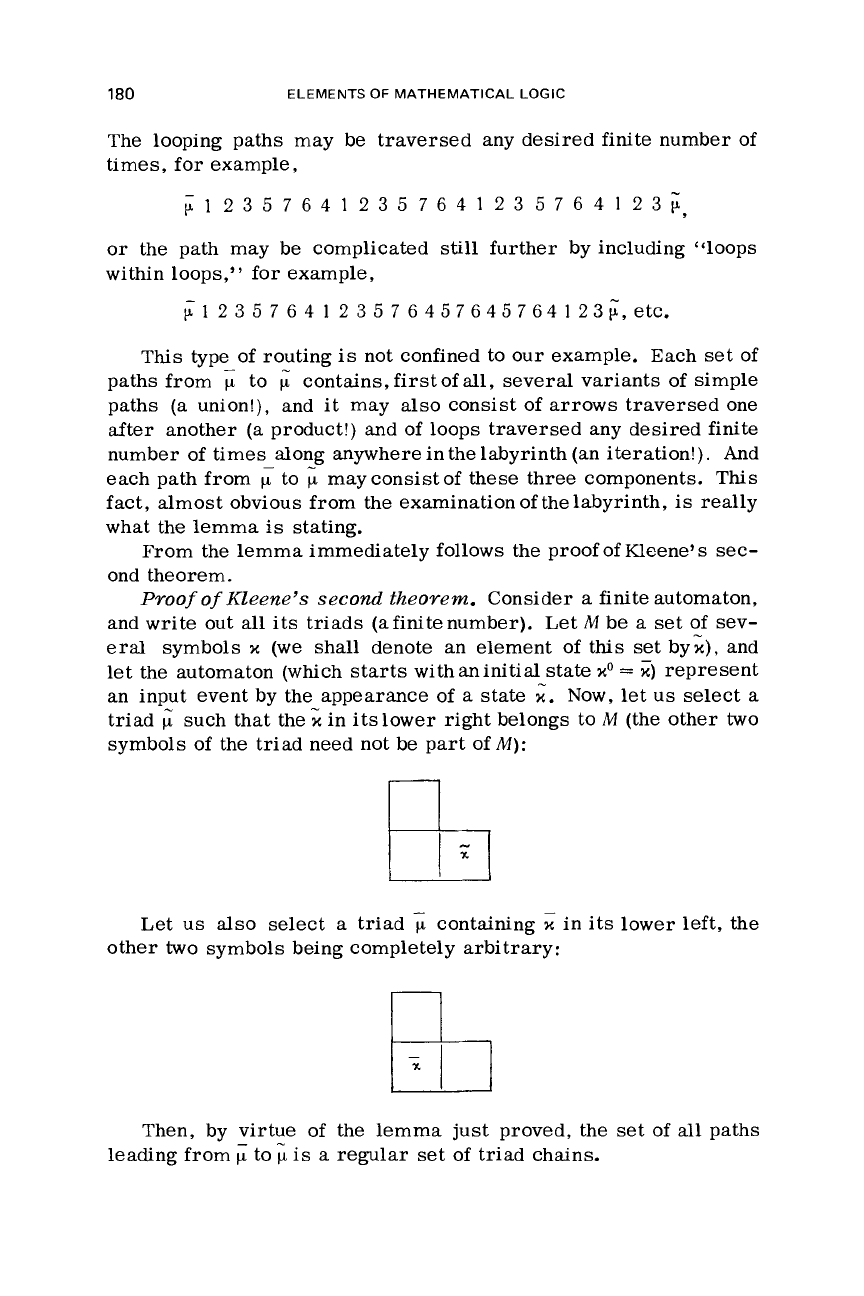
180
ELEMENTS
OF
MATHEMATICAL LOGIC
The looping paths may be traversed any desired finite number of
times, for example,
F1
235
7641
235
7641
23
576 4 123;,
or
the path may be complicated
still
further by including “loops
within loops,” for example,
r-1
2
3
5
7 6
4
12357 64576457641
23i,etc.
This type of routing
is
not confined to our example. Each set of
paths from to contains,firstof all, several variants of simple
paths
(a
union!), and
it
may also consist of
arrows
traversed one
after another
(a
product!) and of loops traversed any desired
finite
number of times along anywhere in the labyrinth (an iteration!). And
each path from
p
to
p
may consistof these three components.
This
fact, almost obvious from the examination of the labyrinth,
is
really
what the lemma
is
stating.
From the lemma immediately follows the proof of Kleene’s
sec-
ond theorem.
Proof
of
Kleene’s second theorem.
Consider
a
finite automaton,
and write out
all
its triads (afinitenumber). Let
M
be
a
set
of sev-
eral
symbols
x
(we
shall denote an element of
this
set
by;), and
let the automaton (which starts withaninitial
state
xo
=
z)
represent
an input event by the appearance of
a
state
k.
Now,
let
us select
a
triad
;I
such that the
k
in itslower right belongs to
M
(the
other
two
symbols of the triad need not be part of
M):
--
Let us also select
a
triad containing
x
in its lower left, the
other
two
symbols being completely arbitrary:
Then, by virtue of
the
lemma just proved,
the
set
of
all
paths
--
leading from
p
to
p
is
a
regular set of
triad
chains.
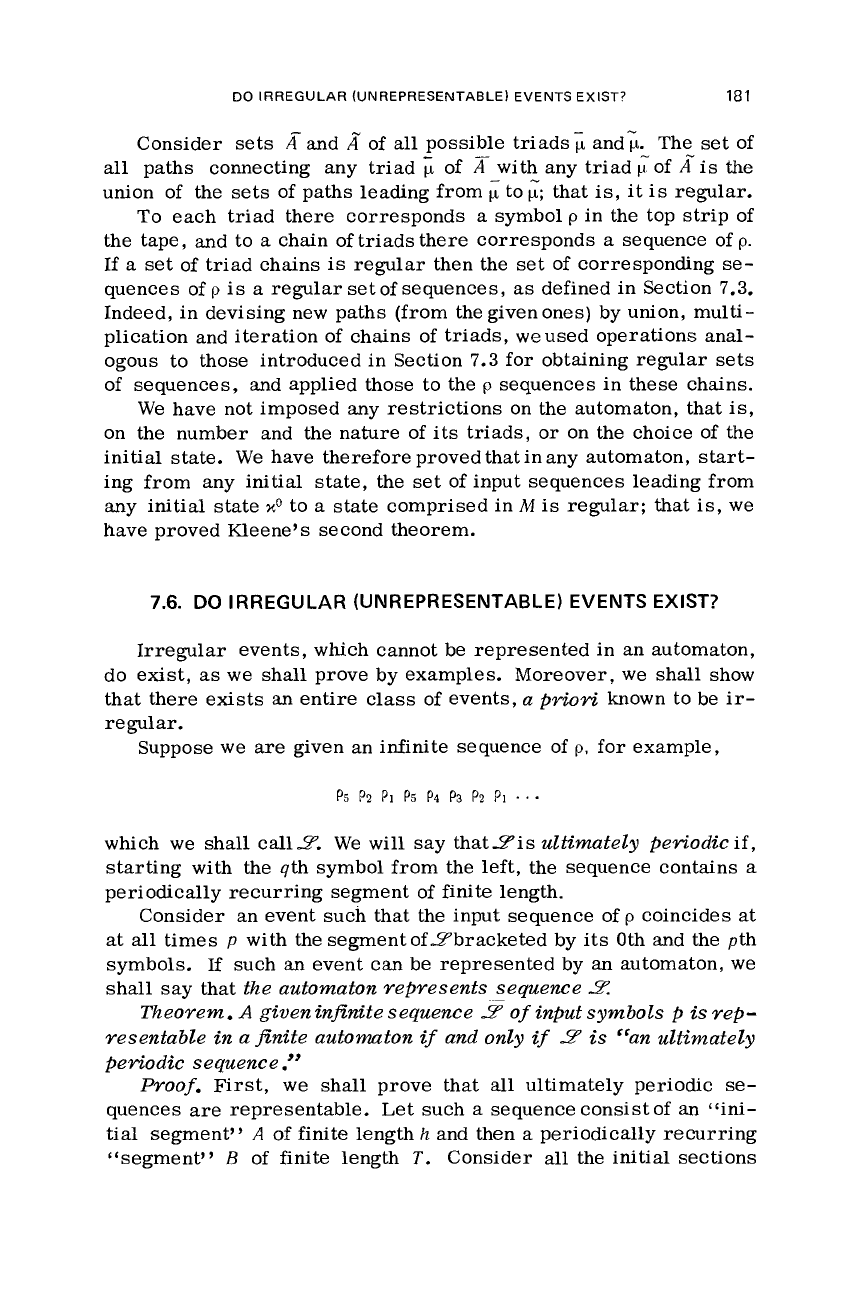
DO
IRREGULAR (UNREPRESENTABLE) EVENTS EXIST?
181
Consider sets
K
and
A”
of
all
possible triadsi and;. The set
of
all
paths connecting any triad
of
A”
is
the
union of the sets of paths leading from
p
to
p;
that
is,
it
is
regular.
To
each triad there corresponds
a
symbol
p
in the top strip
of
the tape, and to
a
chain of triads there corresponds a sequence of
p.
If
a
set of triad chains
is
regular then the set
of
corresponding
se-
quences
of
p
is
a
regular set of sequences,
as
defined in Section
7.3.
Indeed, in devising new paths (from the givenones) by union, multi-
plication and iteration
of
chains of triads,
we
used operations anal-
ogous to those introduced in Section
7.3
for
obtaining regular sets
of
sequences, and applied those to the
p
sequences in
these
chains.
We
have not imposed any restrictions on the automaton, that is,
on the number and the nature of
its
triads, or on the choice of the
initial state.
We
have therefore proved that in any automaton, start-
ing from any
initial
state, the
set
of
input sequences leading from
any
initial
state
xo
to
a
state
comprised in
M
is
regular; that is,
we
have proved Kleene’s second theorem.
of
K
with any triad
--
7.6.
DO
IRREGULAR (UNREPRESENTABLE) EVENTS EXIST?
Irregular events, which cannot be represented in an automaton,
do exist,
as
we shall prove by examples.
Moreover, we shall show
that there exists an entire
class
of events,
a
p&ri
known to be
ir-
regular.
Suppose
we
are
given an infinite sequence
of
p,
for example,
PS
P2
PI
PS
P4
P3
P2
PI
.
’
.
which
we
shall
call
9.
We
will
say that
3’is
ultimately periodic if,
starting with the
qth
symbol from the left, the sequence contains
a
periodically recurring segment of
finite
length.
Consider an event such that the input sequence of
p
coincides at
at
all
times
p
with the segment ofzbracketed by its 0th and the pth
symbols. If such
an
event can be represented by an automaton,
we
shall
say that
the automaton represents sequence
3
Theorem.
A
giveninfinite sequence
9
of input symbols
p
is
rep-
resentable in a finite automaton if and only if
3
is
“an ultimately
periodic sequence
.”
Proof.
First,
we
shall prove that
all
ultimately periodic
se-
quences
are
representable. Let such
a
sequence consist
of
an
“ini-
tial
segment’’
A
of
finite length
h
and then
a
periodically recurring
“segment”
B
of
finite
length
T.
Consider
all
the
initial sections
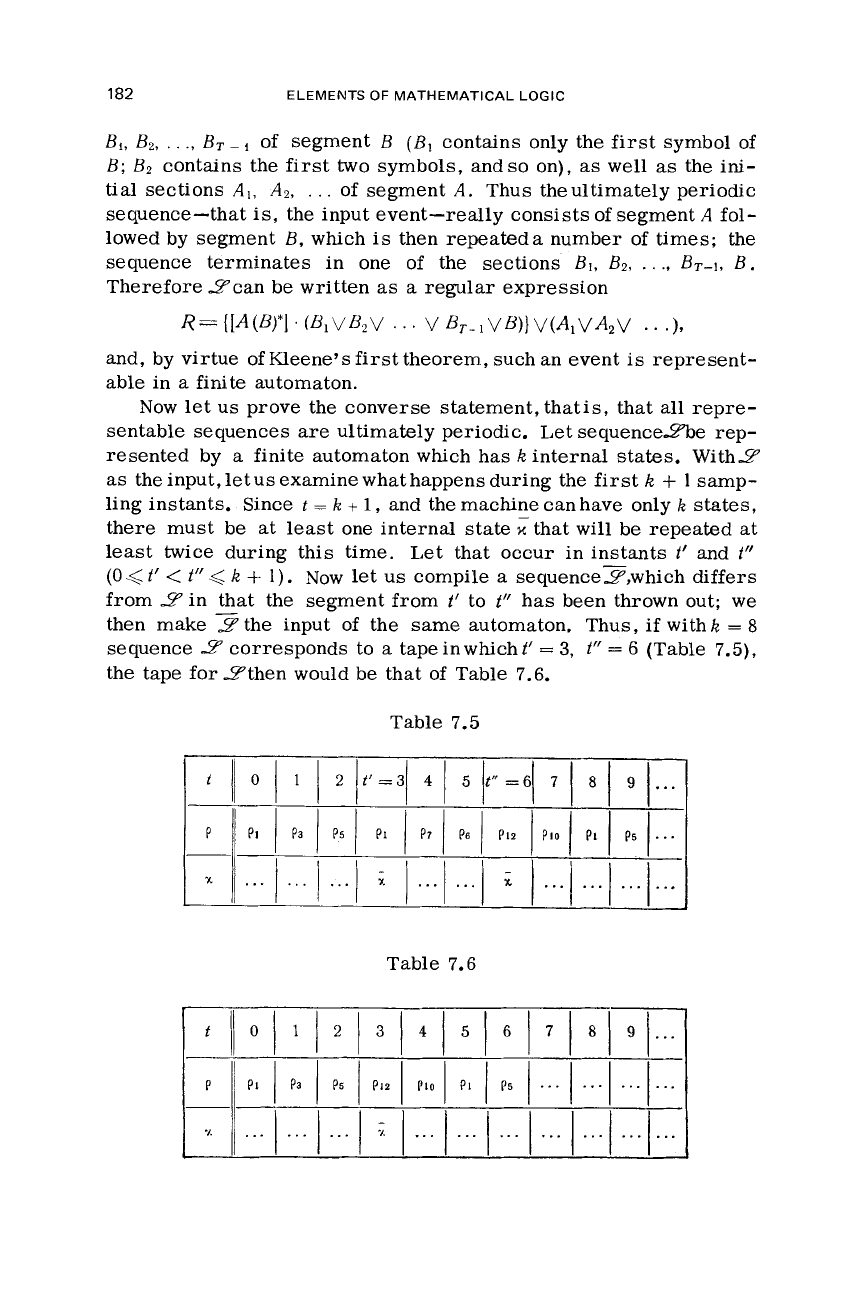
182
ELEMENTS
OF
MATHEMATICAL LOGIC
x
B,,
Bz,
.
.
.,
BT
of
segment
B
(B,
contains only the first symbol of
B;
BZ
contains the first
two
symbols, andso on),
as
well
as
the
ini-
tial sections
A,,
A*.
. . .
of segment
A.
Thus theultimately periodic
sequence-that is, the input event-really consists of segment
A
fol-
lowed by segment
B,
which
is
then repeateda number of times; the
sequence terminates in one
of
the sections
Bt,
Bz,
.
.
.,
BT-1,
B.
Therefore 2can be written
as
a
regular expression
R=
([A(B)*]
(BiVBZV
.
. .
V
Bp1VB)}V(A1VA2V
.
.
.),
and, by virtue of Kleene’s first theorem, such an event
is
represent-
able in
a
finite automaton.
Now let
us
prove the converse statement, thatis, that
all
repre-
sentable sequences
are
ultimately periodic. Let sequencene rep-
resented by
a
finite automaton which has
k
internal
states.
With3
as the input, let
us
examine what happens during the
first
k
+
1
samp-
ling instants. Since
t
=
k
+
1,
and the machine can have only
k
states,
there must be at
least
one internal state that will be repeated
at
least twice during this time, Let that occur in instants
t’
and
f”
(0
4
f’
<
t”
4
k
+
1).
Now let
us
compile
a
sequence?,which differs
from
2
in that the segment from
t’
to
t”
has been thrown out; we
then make
2
the input
of
the
same
automaton. Thus, if withk
=
8
sequence
2
corresponds to a tape inwhicht‘
=
3,
t”
=
6 (Table 7.5),
the tape for 9then would be that of Table 7.6.
...
i
...
I
...
Table 7.5
f’
=
31
4
1
5
/t‘
=6(
7
PI
1
PI
1
Pe
1
PI2
1
PI0
x
I...l...)
x
I...
Table 7.6
-
...
-
...
-
...
-
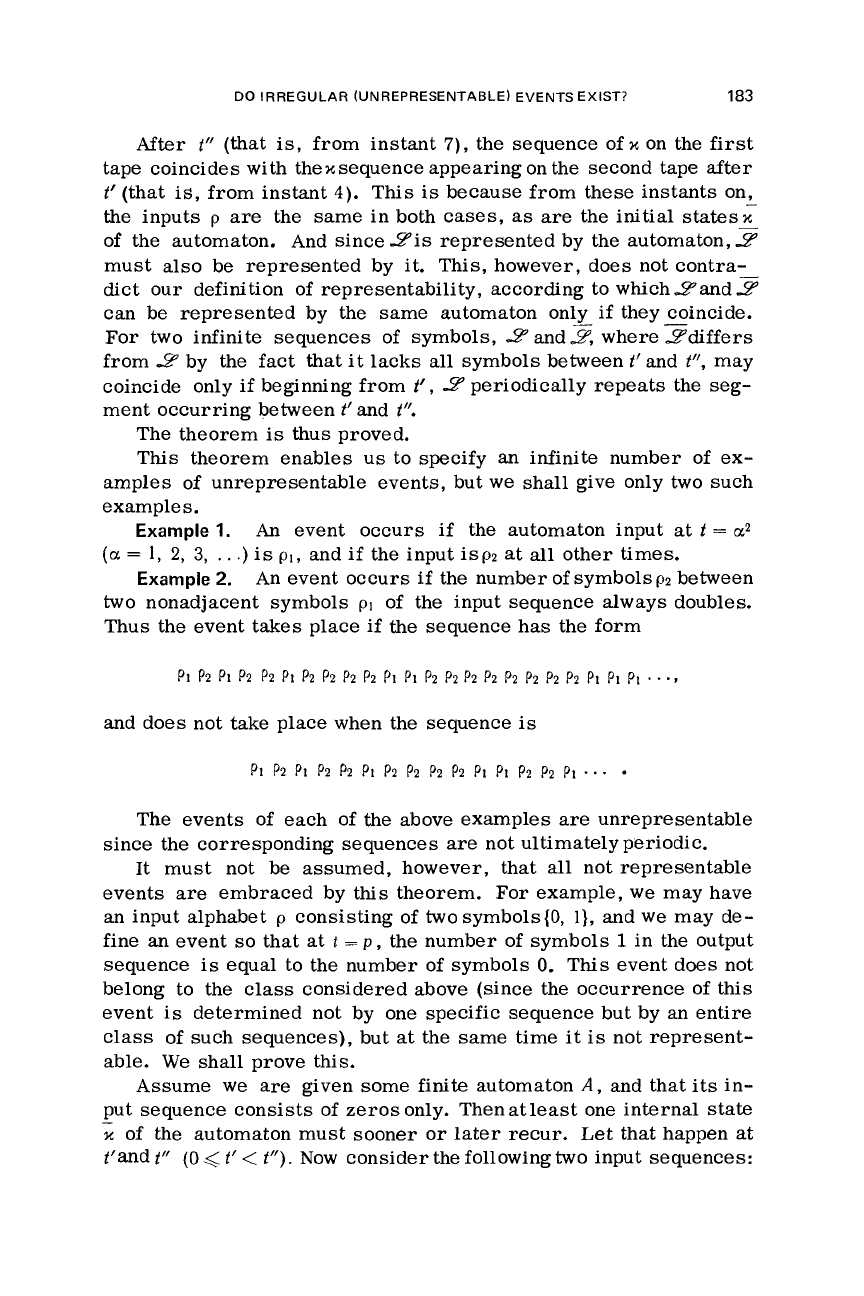
DO
IRREGULAR (UNREPRESENTABLE) EVENTS EXIST?
183
After
t”
(that
is,
from instant
7),
the sequence of
x
on the first
tape coincides with thex sequence appearing on the second tape
after
t’
(that is, from instant
4).
This
is
because from these instants on,
the inputs
p
are
the same in both cases,
as
are
the initial
states;
of
the automaton. And since
3is
represented by the automaton,
2
must also be represented by it.
This, however, does not contra-
dict
our definition of representability, according to which2and
2
can be represented by
the
same automaton only if they coincide.
For
two infinite sequences of symbols,
3
and
5,
where
3differs
from
9
by the fact that it lacks
all
symbols between
t’
and
tN,
may
coincide only
if
beginning from
t’,
3
periodically repeats the seg-
ment occurring between
t’
and
t”.
The theorem
is
thus proved.
This theorem enables us to specify
an
infinite number of ex-
amples
of
unrepresentable events, but
we
shall give only two such
examples.
Example
1.
An
event occurs
if
the automaton input at
t
=
a2
(a
=
1,
2,
3,
.
.
.)
is
pi,
and
if
the input
ispz
at
all
other times.
Example
2.
An event occurs
if
the number of symbols
p2
between
two
nonadjacent symbols
pl
of the input sequence always doubles.
Thus
the
event takes place
if
the sequence has the form
P1 Pz PI Pz Pz P1
Pz
P2 Pz Pz PI
PI
Pz Pz
P2
Pz Pz Pz Pz
Pz
PI
P1 P1
*
*
-v
and does not
take
place when the sequence
is
PI Pz P1
P2
P2 PI
Pz
PZ PZ Pz P1 PI Pz
Pz
P1
*
The events of each of the above examples
are
unrepresentable
since the corresponding sequences
are
not ultimately periodic.
It must not be assumed, however, that
all
not representable
events
are
embraced by this theorem.
For
example,
we
may have
an
input alphabet
p
consisting of two symbols
(0,
l},
and
we
may de-
fine
an
event
so
that at
t
=
p,
the number of symbols
1
in the output
sequence
is
equal to the number of symbols
0.
This event does not
belong to the
class
considered above (since the occurrence
of
this
event
is
determined not by one specific sequence but by an entire
class
of such sequences), but
at
the same time
it
is
not represent-
able.
We
shall prove this.
Assume we
are
given some
finite
automaton
A,
and that
its
in-
put sequence consists of zeros only. Then
at
least one internal state
x
of the
automaton must sooner
or
later
recur.
Let that happen at
t’and
t”
(0
,<
t’
<
t”).
Now consider the following
two
input sequences:
-
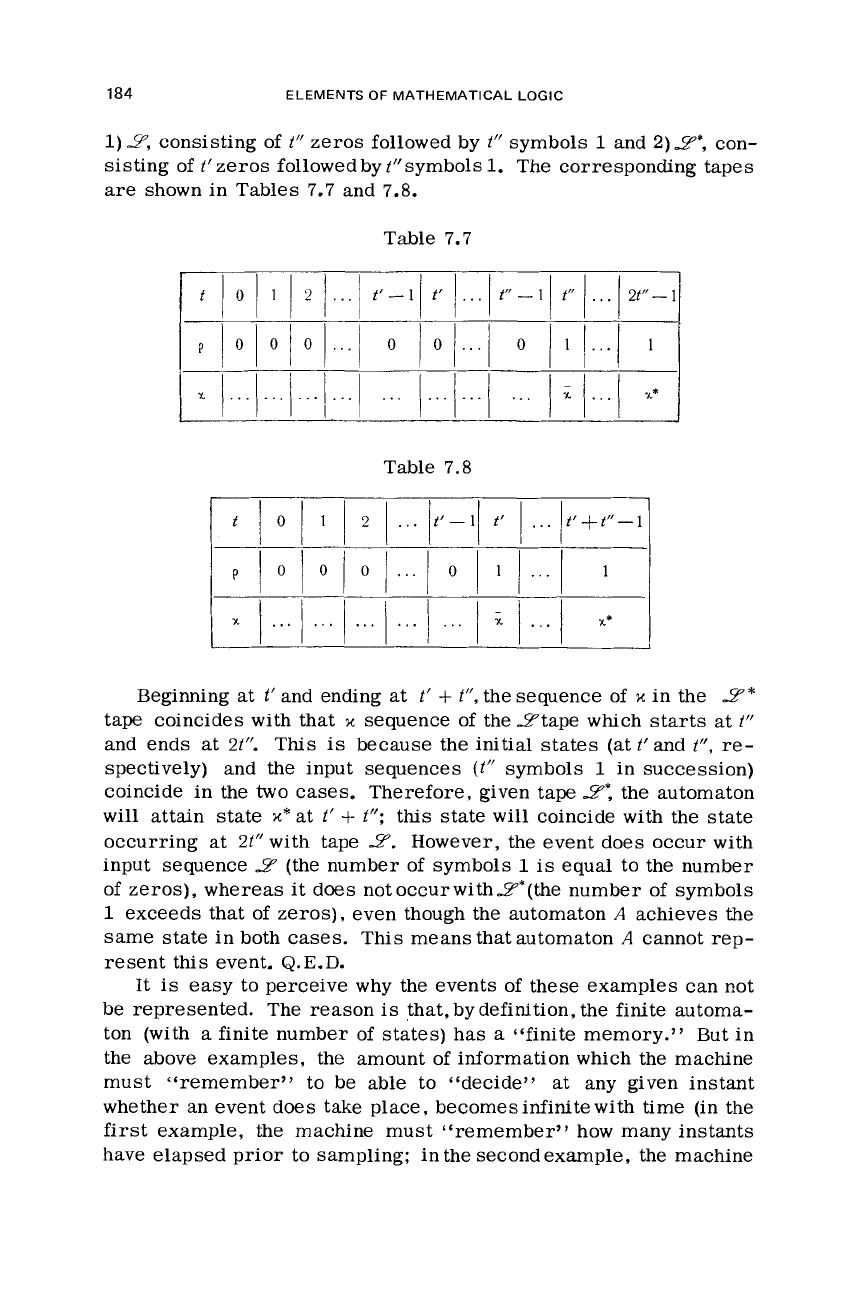
184
ELEMENTS
OF
MATHEMATICAL LOGIC
1)
9,
consisting of
t”
zeros followed by
t”
symbols
1
and
2)
9,
con-
sisting
of
f’zeros followed by f”symbo1s
1.
The corresponding tapes
are
shown in Tables
7.7
and
7.8.
Table
7.7
Beginning at t’and ending at
t’
+
t”,
thesequence of
x
in the
L?*
tape coincides with that
x
sequence of the 3tape
which
starts at
t”
and ends at
2t”.
This
is
because the initial states (at
t’
and
t”,
re-
spectively)
and the input sequences
(,’’
symbols
1
in succession)
coincide in the
two
cases. Therefore, given tape
2:
the
automaton
will
attain state
x*
at
t’
+
t”;
this state
will
coincide with the state
occurring at 2t”with tape
3.
However, the event does occur with
input sequence
3
(the number of symbols
1
is
equal to the number
of
zeros), whereas it does notoccurwithZ*(the number of symbols
1
exceeds that of zeros), even though the automaton
A
achieves
the
same
state
in both
cases.
This means that automaton
A
cannot rep-
resent this event.
Q.E.D.
It
is
easy to perceive why the events of these examples can not
be represented. The reason
is
that, by definition, the finite automa-
ton (with
a
finite number of states) has
a
“finite memory.” But in
the above examples, the amount of information which the machine
must “remember” to be able to “decide”
at
any given instant
whether an event does take place, becomesinfinitewith time (in the
first example, the machine must “remember” how many instants
have elapsed prior to sampling; in the second example, the machine
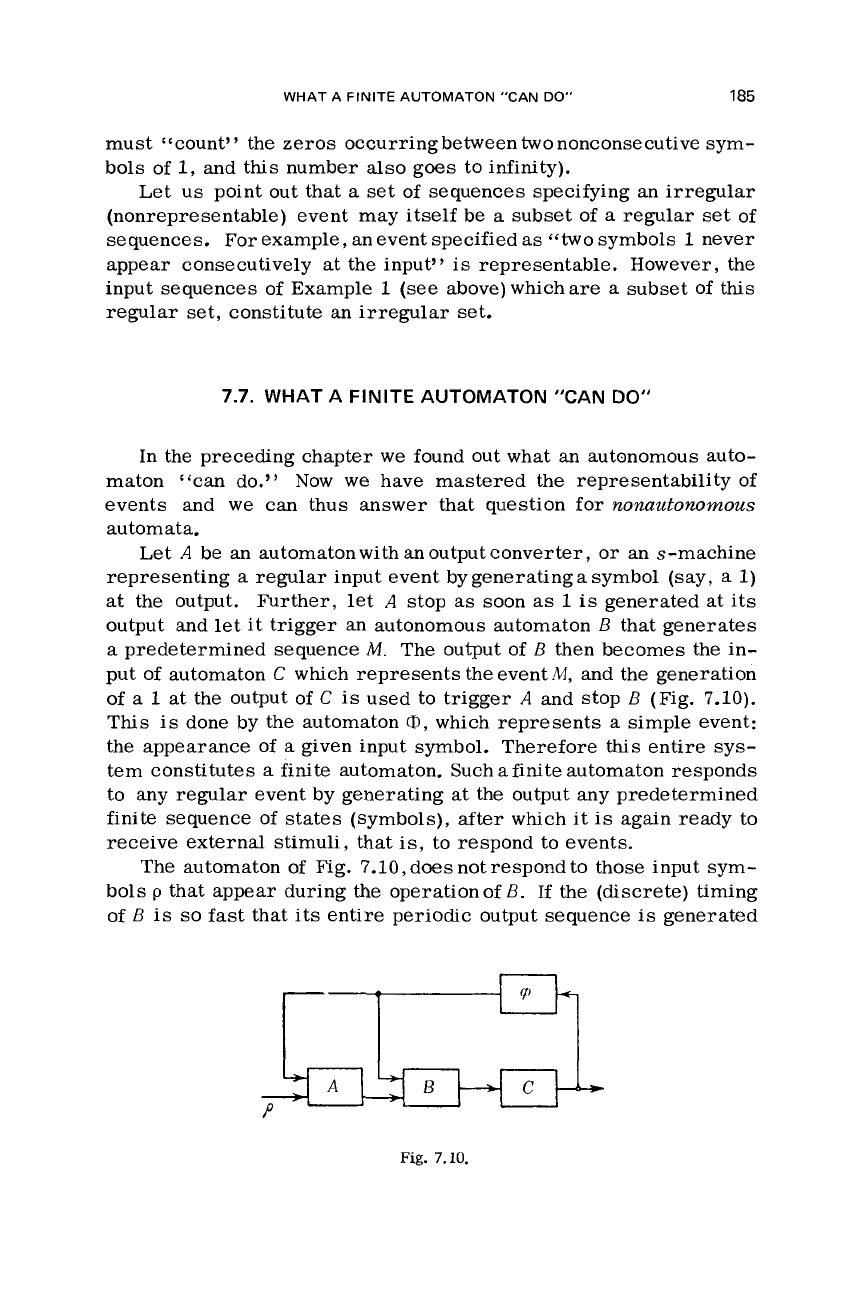
WHAT A FINITE AUTOMATON “CAN
DO”
185
T
must “count’ ’ the zeros occurring between
two
nonconsecutive sym-
bols of
1,
and
this
number
also
goes to infinity).
Let us point out that
a
set
of sequences specifying an irregular
(nonrepresentable) event may
itself
be
a
subset of
a
regular set
of
sequences. For example, an event specified as
“two
symbols
1
never
appear consecutively at the input’’
is
representable. However, the
input sequences of Example
1
(see
above)whichare
a
subset of this
regular set, constitute an irregular set.
7.7.
WHAT A FINITE AUTOMATON
”CAN
DO”
In the preceding chapter
we
found out what an autonomous auto-
maton “can do.” Now
we
have mastered the representability of
events and
we
can thus answer that question for
nomutonornous
automata.
Let
A
be an automatonwith an output converter, or an s-machine
representing
a
regular input event by generating
a
symbol (say,
a
1)
at
the output. Further, let
A
stop
as
soon
as
1
is
generated at its
output and let it trigger an autonomous automaton
B
that generates
a
predetermined sequence
M.
The output of
B
then becomes the in-
put
of
automaton
C
which represents the event
M,
and the generation
of
a
1
at the output of
C
is
used to trigger
A
and stop
B
(Fig.
7.10).
This
is
done by the automaton
0,
which
represents
a
simple event:
the appearance of
a
given input symbol. Therefore this entire sys-
tem constitutes
a
finite automaton. Such
afinite
automaton responds
to any regular event by generating at
the
output any predetermined
finite sequence
of
states (symbols), after which it
is
again ready to
receive external stimuli, that
is,
to respond to events.
The automaton of Fig.
7.10,
does not respond to those input sym-
bols
p
that appear during the operationof
B.
If the (discrete) timing
of
B
is
so
fast
that
its
entire periodic output sequence
is
generated
n
Fig.
7.10.
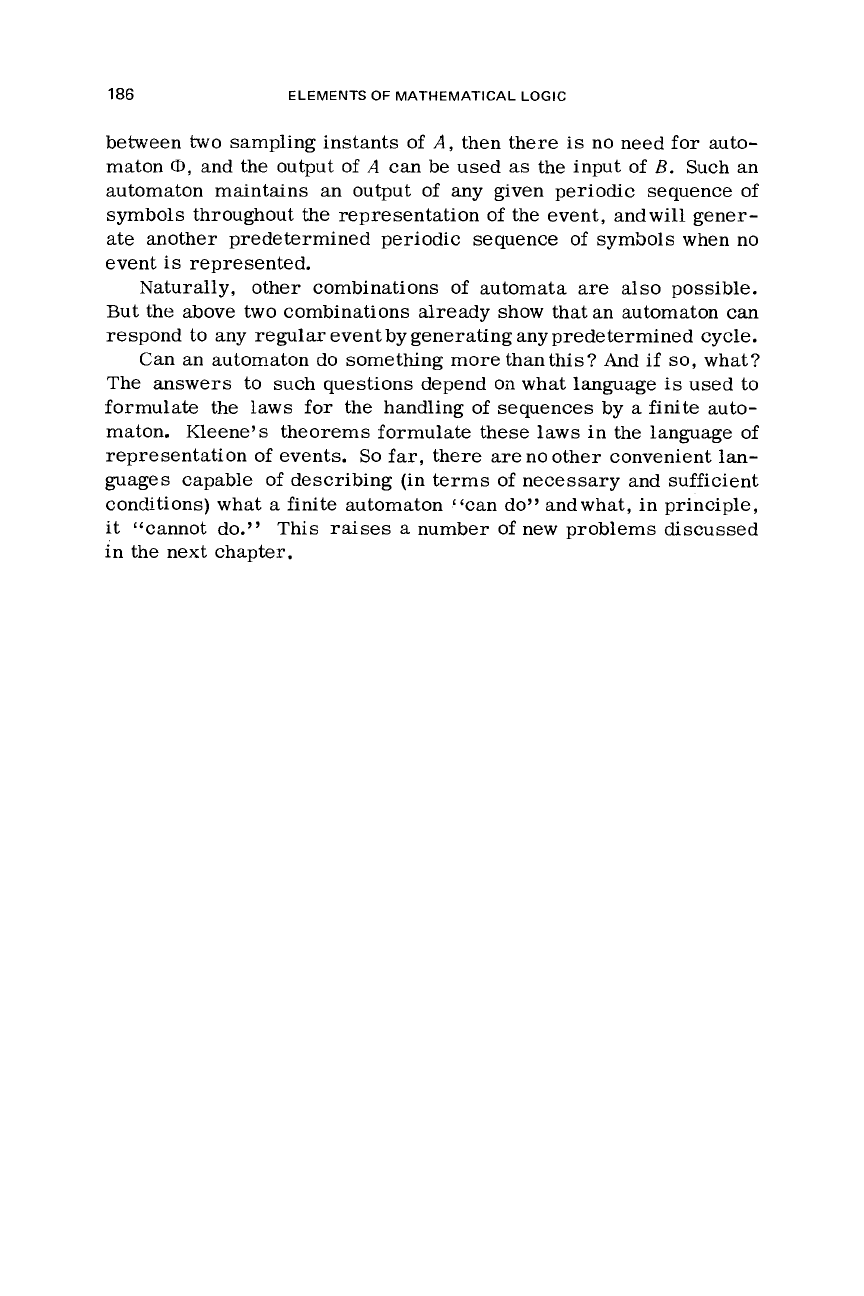
186
ELEMENTS
OF
MATHEMATICAL LOGIC
between two sampling instants of
A,
then there
is
no need
for
auto-
maton
@,
and the output of
A
can be used
as
the input of
B.
Such an
automaton maintains an output of any given periodic sequence of
symbols throughout the representation of the event, andwill gener-
ate another predetermined periodic sequence of
symbols
when no
event
is
represented.
Naturally, other combinations of automata
are
also possible.
But the above two combinations already show that an automaton can
respond
to
any regular event by generating any predetermined cycle.
Can an automaton do something more than this? And
if
so,
what?
The answers to such questions depend
on
what language
is
used to
formulate the
laws
for the handling of sequences by a finite auto-
maton. Kleene’s theorems formulate these
laws
in
the
language of
representation of events.
So
far,
there
are
no other convenient lan-
guages capable of describing (in terms of necessary and sufficient
conditions) what
a
finite automaton “can do” andwhat, in principle,
it “cannot do.” This
raises
a
number of new problems discussed
in
the
next chapter.
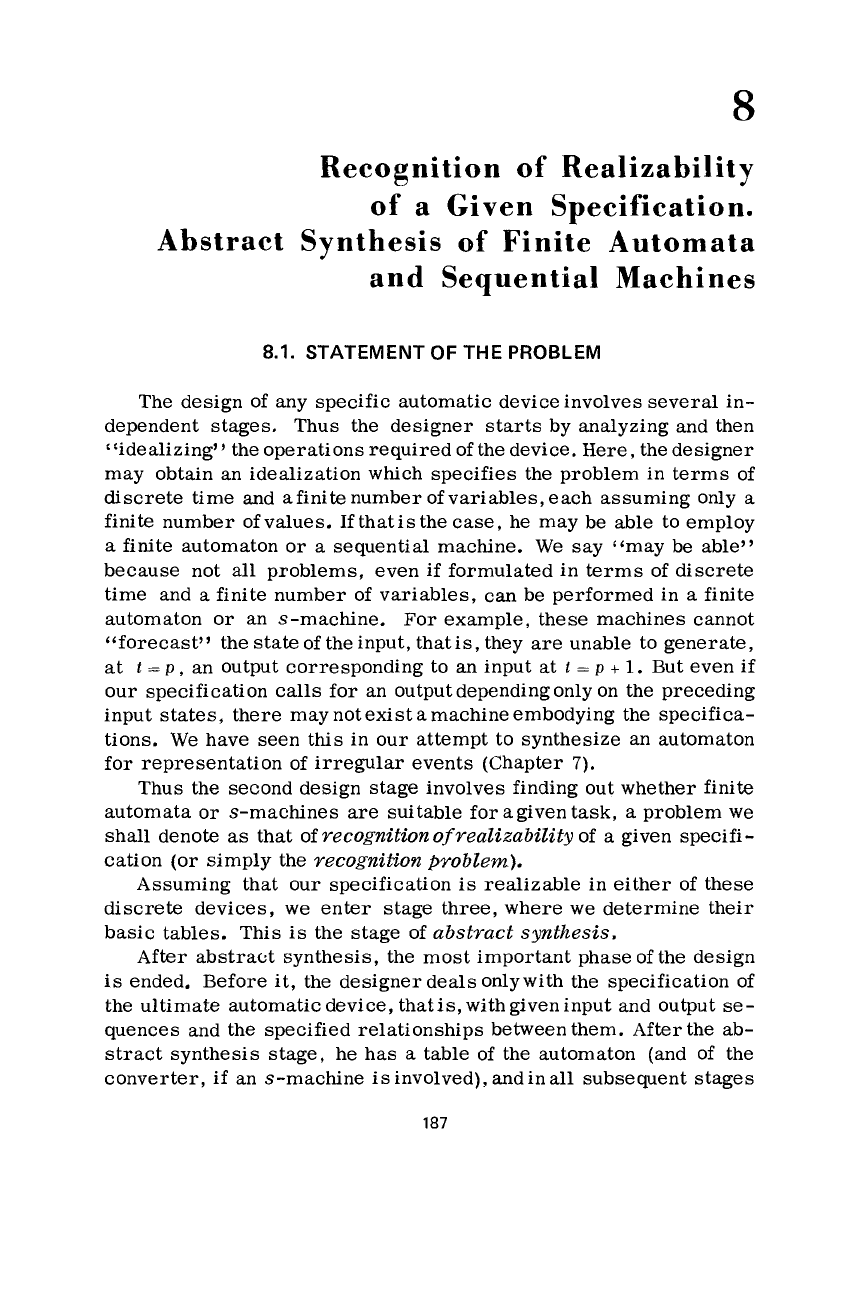
8
Recognition
of
Realizability
of
a
Given
Specification.
Abstract Synthesis
0f
Finite
Automata
and Sequential Machines
8.1.
STATEMENT
OF
THE PROBLEM
The design of any specific automatic device involves several in-
dependent stages. Thus the designer starts by analyzing and then
“idealizing” the operations required of the device. Here, the designer
may obtain an idealization which specifies the problem in terms of
discrete time and afinite number of variables, each assuming only
a
finite number of values. If that
is
the
case,
he may be able to employ
a
finite automaton or
a
sequential machine.
We
say “may be able”
because not
all
problems, even
if
formulated in terms of discrete
time and
a
finite number of variables, can be performed in
a
finite
automaton or an s-machine. For example, these machines cannot
“forecast” the
state
of the input, that is, they
are
unable to generate,
at
t
=
p
,
an output corresponding to an input at
t
=
p
+
1.
But even
if
our specification
calls
for an output depending only on the preceding
input states,
there
may notexist
a
machine embodying the specifica-
tions.
We
have seen this in our attempt to synthesize an automaton
for representation of irregular events (Chapter
7).
Thus
the
second design stage involves finding out whether finite
automata or s-machines
are
suitable for agiven task,
a
problem
we
shall denote
as
that of
Yecognition
of
Yealizability
of
a
given specifi-
cation (or simply the
recognition problem).
Assuming that our specification
is
realizable in either of these
discrete
devices, we enter stage three, where we determine their
basic tables. This
is
the stage of
abstract synthesis.
After
abstract synthesis, the most important phase of the design
is
ended. Before it, the designer deals onlywith the specification of
the ultimate automatic device, that
is,
withgiven input and output
se-
quences and
the
specified relationships between them.
After
the
ab-
stract synthesis stage, he has
a
table of the automaton (and of the
converter,
if
an s-machine
is
involved), andin all subsequent stages
I
a7
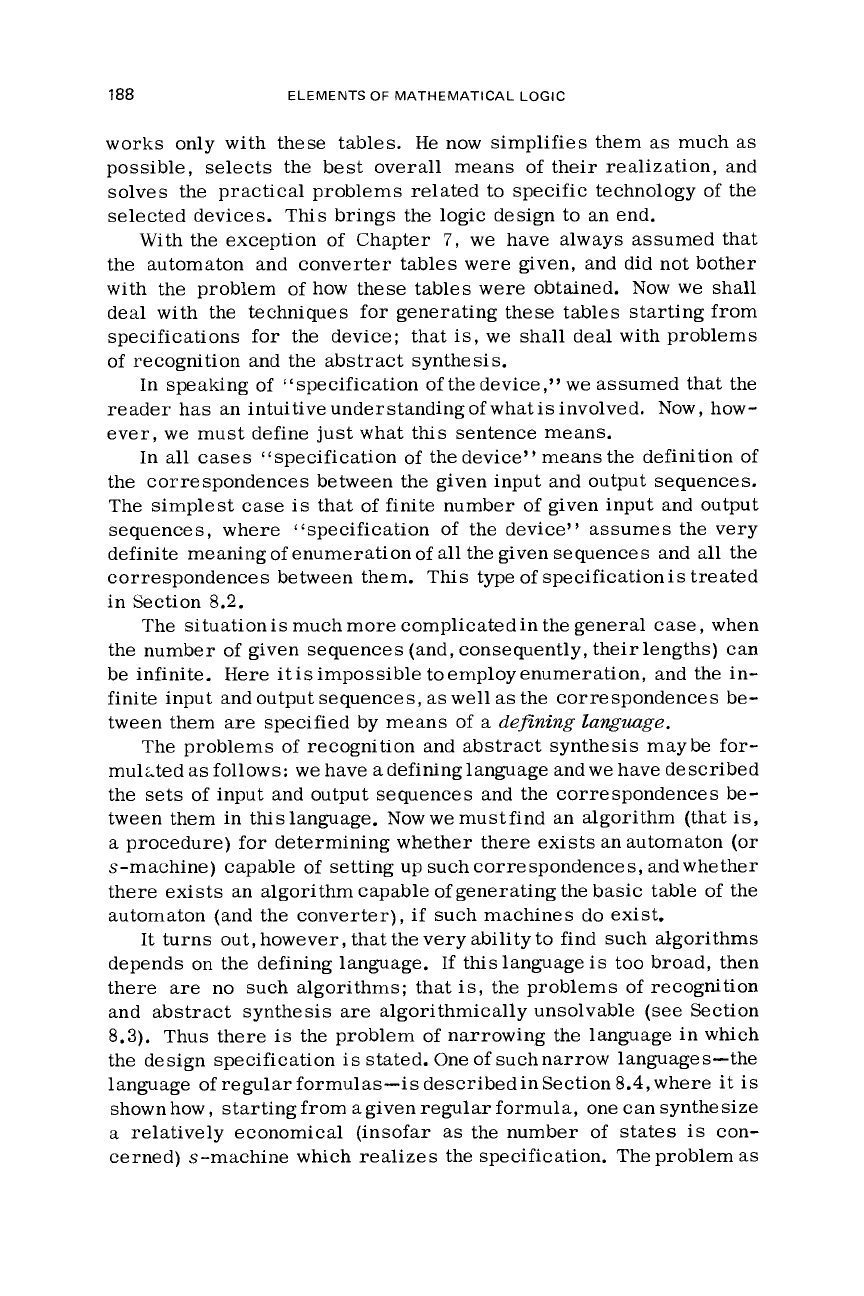
188
ELEMENTS
OF
MATHEMATICAL LOGIC
works only with these tables. He now simplifies them
as
much
as
possible, selects the best overall means of their realization, and
solves the practical problems related to specific technology of the
selected devices. This brings the logic design to an end.
With the exception of Chapter
7,
we
have always assumed that
the automaton and converter tables were given, and did not bother
with the problem of how these tables
were
obtained. Now
we
shall
deal with the techniques
for
generating these tables starting from
specifications for the device; that is,
we
shall deal with problems
of recognition and the abstract synthesis.
In speaking of “specification of the device,”
we
assumed that
the
reader has an intuitive understanding ofwhat
is
involved. Now, how-
ever,
we
must define just what this sentence means.
In
all
cases “specification of the device” means the definition of
the correspondences between the given input and output sequences.
The simplest case
is
that of finite number of given input and output
sequences,
where
“specification of
the
device” assumes the very
definite meaning of enumeration of all the given sequences and all the
correspondences between them. This type
of
specificationis treated
in Section
8.2.
The situationis much more complicatedin the general case, when
the number of given sequences (and, consequently, their lengths) can
be infinite.
Here
it
is
impossible to employ enumeration, and the in-
finite input and output sequences, as
well
as
the correspondences be-
tween them are specified by means of
a
defining
language.
The problems of recognition and abstract synthesis maybe for-
mukted as follows:
we
have adefininglanguage andwe have described
the sets of input and output sequences and the correspondences be-
tween them in this language. Now
we
must find an algorithm (that is,
a procedure)
for
determining whether there exists an automaton
(or
s-machine) capable of setting up such correspondences, and whether
there exists an algorithm capable of generating the basic table of the
automaton (and
the
converter),
if
such machines do exist.
It
turns out, however, that the very ability to find such algorithms
depends on the defining language.
If
this language
is
too broad, then
there are no such algorithms; that
is,
the problems of recognition
and abstract synthesis
are
algorithmically unsolvable
(see
Section
8.3).
Thus there
is
the problem of narrowing the language in which
the design specification
is
stated. One of suchnarrow languages-the
language of regular formulas-is describedin Section
8.4,
where
it
is
shown how, startingfrom
a
given regular formula, one can synthesize
a relatively economical (insofar
as
the number of states
is
con-
cerned) s-machine which realizes the specification. The problem
as
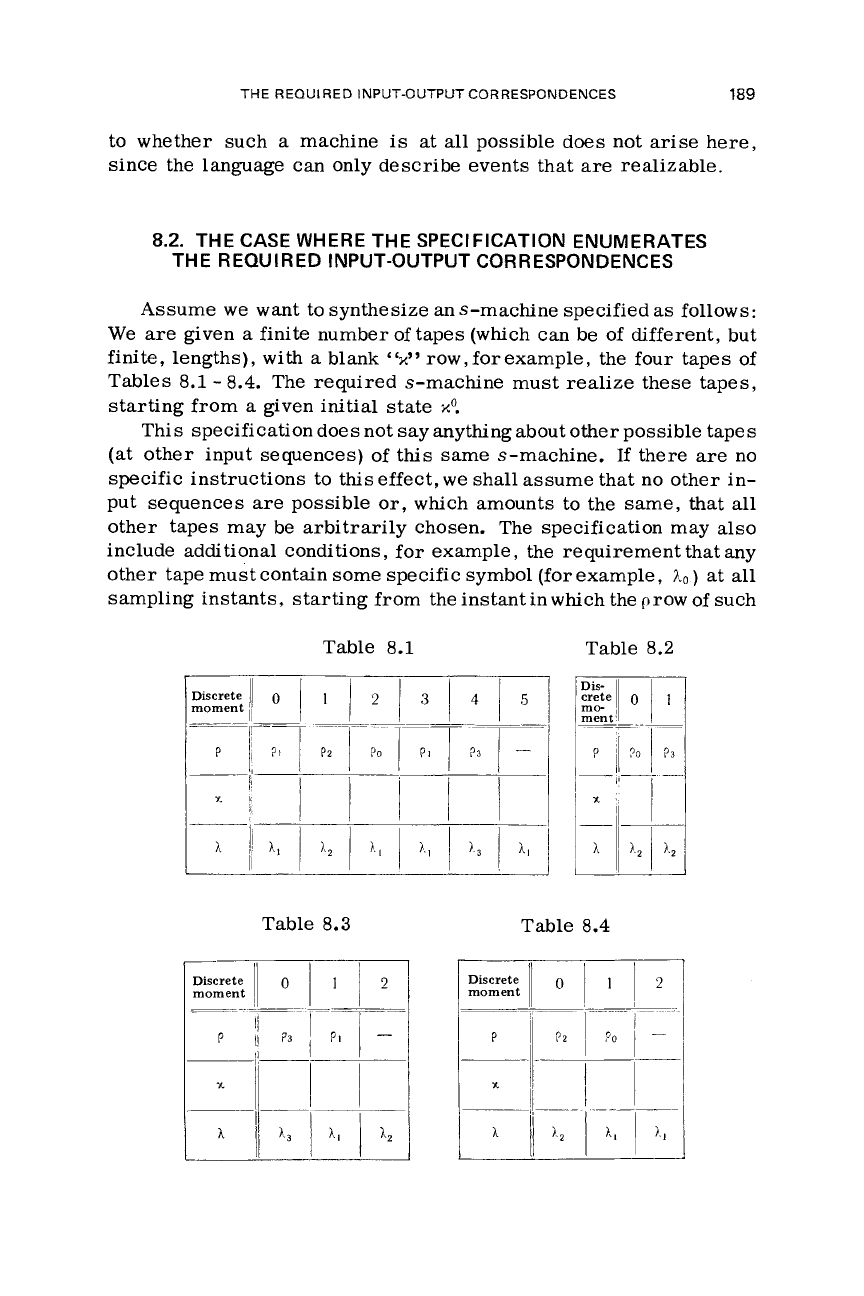
THE REQUl
RED
INPUT-OUTPUT CORRESPONDENCES
189
to whether such
a
machine
is
at
all
possible
does
not
arise
here,
since the language can only describe events that
are
realizable.
8.2.
THE CASE WHERE THE SPECIFICATION ENUMERATES
THE REQUIRED INPUT-OUTPUT CORRESPONDENCES
Assume
we
want to synthesize an s-machine specified
as
follows:
We
are
given a finite number of tapes
(which
can be of different, but
finite, lengths), with
a
blank
“2’
row, for example, the four tapes of
Tables
8.1
-
8.4.
The required s-machine must realize these tapes,
starting from
a
given initial state
xo.
This specification does not say anything about other possible tapes
(at other input sequences) of
this
same s-machine.
If
there
are
no
specific
instructions to
this
effect,
we
shall assume that no other in-
put sequences
are
possible
or,
which amounts to the same, that all
other tapes may be arbitrarily chosen. The specification may also
include additional conditions, for example,
the
requirement that any
other tape must contain some specific symbol (for example,
7..o
)
at all
sampling instants, starting from the instant in which the prow of such
Table
8.1
Table
8.2
Table
8.3
Table
8.4
